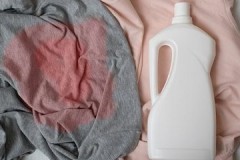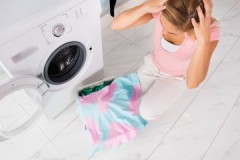Special care, or how to wash a swimsuit
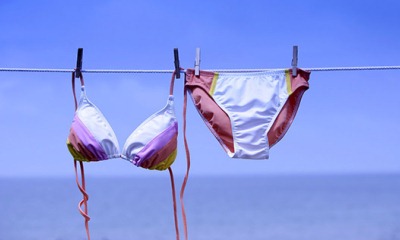 Despite the fact that a swimsuit spends most of its life in the water, it is necessary to wash it. But if you do it casually, then beautiful beachwear becomes an unsightly rag.
Despite the fact that a swimsuit spends most of its life in the water, it is necessary to wash it. But if you do it casually, then beautiful beachwear becomes an unsightly rag.
Therefore, so that all the efforts spent in choosing a bathing suit are not wasted, special care is required for a summer thing.
Is it possible and how to properly wash a leotard (for rhythmic gymnastics, after the sea, etc.) in a washing machine and by hand, we will tell in the article.
Content
Is it possible?
Swimwear is a delicate thing, and a fairly rough machine wash can damage the fibers of the fabric... In addition, a fast rotating drum can stretch the material and ruin the cups.
Some modern models of clippers are equipped with a super-gentle delicate mode, which sometimes washes softer than manual cleaning. In this case, automatic washing is acceptable; in all the rest, it is better to give preference to hand wash.
Bikinis are divided into two types: regular and sports.... The latter are characterized by increased material durability, so a machine wash with a delicate cycle will not damage.
But the matter of the former is more picky and is often supplemented with various accessories, but some manufacturers allow automatic washing.
 In what cases is machine washing strictly prohibited:
In what cases is machine washing strictly prohibited:
- if the top is made in the likeness of a bra - there are bones, silicone or helium inserts, voluminous cups;
- there is embroidery, jewelry made of beads, rhinestones, sequins, etc .;
- there are metal inserts or clasp;
- if the swimsuit is handmade.
How often?
Swimming clothes should be washed after every wear, despite regular contact with water. The fact is that fresh water bodies stain matter with silt and underwater vegetation, and the increased salt level in the sea settles on the tissue and eats it away.
Pool water soaked in bleach also adversely affects the material... Therefore, after each going ashore, you should rinse your swimsuit with running water, and upon arrival home, be sure to wash.
The first wash is best done immediately after the purchase for aesthetic reasons - it is not known how long the swimsuit spent in a dusty warehouse, how often it fell on a dirty floor and how many fittings it experienced.
Preparation for the process
Before you start washing, you need to "conjure" a little over the swimsuit.
Sand removal
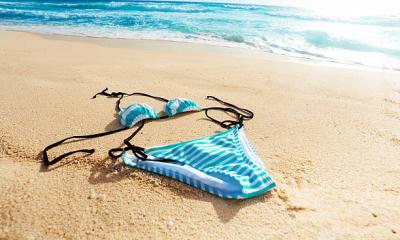 Clogged sand should also be removed in advance, since during washing it can damage the fabric, clogging even deeper, and, if the washing was automatic, ruin the machine.
Clogged sand should also be removed in advance, since during washing it can damage the fabric, clogging even deeper, and, if the washing was automatic, ruin the machine.
Get rid of sand, depending on the condition of the product:
- Dry gently stretched and cleaned with a brush and soft bristles.
- Wet it is washed thoroughly under running water, turning it inside out and paying attention to each fold.
How to wash a swimsuit from the sand, the video will tell you:
Cleaning stains
Traces of creams and oils for and from tanning are the most commonly found on swimwear. They are usually removed before washing.
- cover a greasy spot on both sides with paper napkins;
- with an iron heated to no higher than 100 ° C, gently iron the covered area;
- prepare a solution - liquid washing gel is mixed with ammonia;
- moisten the sponge and wipe off the remaining dirt.
Remove traces of glue
Before washing a new leotard for the first time, remove any residual glue, if any. Most often, the glue remains on the swimming trunks after removing the hygienic film.
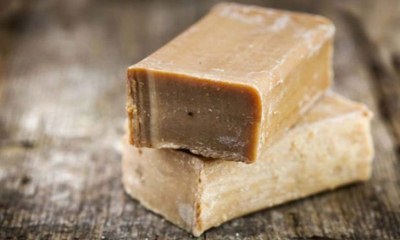 It is removed with:
It is removed with:
- adhesive tape - a piece of scotch tape is applied to the remaining glue and abruptly torn off;
- laundry soap - apply abundant lather from soap to the stained place, leave for 5-7 minutes and remove the rolled glue.
Some sites recommend removing the sticky enzyme with gasoline or thinner. This is not worth doing - the chance that the trunks will deteriorate is higher than the chance that the glue will be removed.
Step-by-step instructions for washing the product
Each type of swimsuit has its own peculiarities when washing.
Usual
Before washing a regular swimsuit, study the recommendations on the tag, remove dirt and sand, and choose a detergent. It is best to use liquid gels, liquid products for moody fabrics, or colorless shampoos, since powders are poorly washed out of the material.
In the washing machine
If washing in a machine is allowed, it is carried out in accordance with simple rules:
- Select "delicate" or "manual" mode.
- The water temperature should not exceed 35 ° C.
- Disable any types of spinning and drying.
- Turn the bikini inside out and put it in a special mesh.
- After washing, do not wring out the clothes, but let the liquid drain slightly, leaving it in the drum.
Manually
Hand washing instructions are also pretty simple:
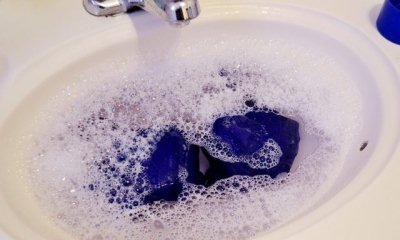 If desired, beachwear can be soaked for 5-10 minutes in cool water.
If desired, beachwear can be soaked for 5-10 minutes in cool water.- Fill the basin with water no more than 35 ° C.
- Add some liquid detergent. It is not recommended to pour a lot so that you do not have to rinse out for too long.
- Beat the product until rich foam.
- Place the swimsuit in water, washing with light pressure. Rubbing, twisting, stretching and carrying out similar aggressive actions with a bikini is prohibited!
- Drain soapy water and add clean water of the same temperature.
- Rinse the swimsuit with vigorous movements.
- Rinse until the water is clear.
- Squeeze out excess liquid with light soft pressure, without twisting the item.
Sports
A denser fabric allows you to machine wash a thing, however, the presence of bones and helium inserts allows only manual cleaning.
In a typewriter
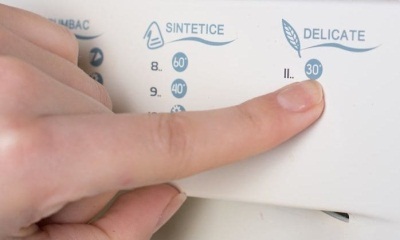 Despite the durability of a sports swimsuit, its automatic washing is similar to washing a regular bikini:
Despite the durability of a sports swimsuit, its automatic washing is similar to washing a regular bikini:
- The preferred mode is “delicate” or “manual”.
- The water is not hotter than 35 ° C.
- Additional functions such as spinning and drying are disabled.
- Pack the swimsuit in a net.
- Do not wring out after washing.
By hands
As with a machine, washing by hand is almost identical to washing a regular bikini:
- Dissolve soapy water in a basin in cool water.
- The swimsuit can be rubbed slightly during washing.
- Rinse until the water is no longer soapy.
- After washing, gently squeeze out the water with your fingers.
All kinds of twisting, twisting, stretching, etc. are prohibited!
For rhythmic gymnastics
Swimwear for gymnastics, figure skating and acrobatics - most demanding in terms of care due to the huge amount of jewelry... In addition, its cost is high, therefore, in order not to spoil the thing, they are extremely careful to wash it.
Before you study the rules for cleaning a gymnastic suit, you should find out what is prohibited to do:
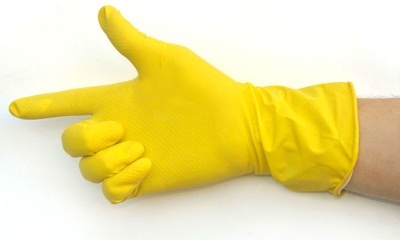 soak;
soak;- wash in hot water;
- use shampoos, powders, gels, conditioners, bleaches, and stain removers. Only baby soap is allowed;
- squeezing, twisting, stretching;
- take it to dry cleaning;
- wash earlier than 12 days after completing the rhinestone pattern.
Correct washing:
- Fill a bowl with water of about 30 degrees.
- Dilute liquid or solid baby soap.
- Slightly push the swimsuit underwater.
- Rub the dirty parts very gently.
- Rinse carefully in clean water.
- Do not squeeze, but wrap in a towel.
How to wash a leotard for rhythmic gymnastics by hand, video instruction:
Features for different materials
Cleaning a swimsuit depends not only on its appearance, but also on the fabric from which it was sewn.
Cotton
Thin cotton swimwear is more often purchased for children or women in position.
Read more about the rules for washing cotton products. here.
Silk
Silk bikinis are only allowed to be washed by hand in thirty-degree water, using liquid detergents specially designed for silk.
Synthetics
Machine wash is acceptable, but hand wash is preferred... The water temperature is not more than 30 ° C, since synthetics are not “friendly” with hot water. Strong friction, squeezing and stretching will damage the material.
Microfiber
This fabric should be washed separately from other fabrics to prevent staining. Machine wash is permissible on a "delicate" cycle, at a water temperature not exceeding 40 ° C. The detergent must not contain harsh chemicals.
We return the original view
Over time, the bright colors of the swimwear fade, and the whites turn yellow or gray, but this is not a reason to despair. It is quite possible to return the previous look of the bikini.
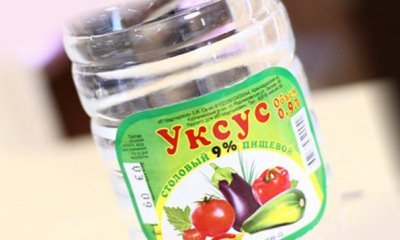 You can restore the color with a stain remover.
You can restore the color with a stain remover.
- Moisten a dense cloth, preferably white, in the product.
- Apply to discolored area for 5-7 minutes.
- Wash in 30 ° C water with a few drops of stain remover.
- Then rinse in a solution of water and vinegar (2: 1) to fix the result.
How to whiten?
A white swimsuit is more capricious than a colored one, and any dirt and yellow spots look like an eyesore.
How to restore the original whiteness:
- using bleach;
- folk remedies.
The rule of thumb for using bleach:
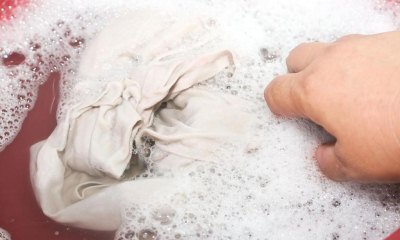 As mentioned, such products are not recommended for swimwear, however, specialized mild chemicals for delicate items that do not contain chlorine are acceptable.
As mentioned, such products are not recommended for swimwear, however, specialized mild chemicals for delicate items that do not contain chlorine are acceptable.- Dissolve a small amount of bleach in 30 ° C water.
- Soak bikini for 10-15 minutes.
- Wash following the hand wash algorithm.
- Some bleaches can be machine washed, unless otherwise prohibited by the manufacturer.
The use of folk remedies:
- In 1 liter of cool water, mix 5 ml of ammonia and 25 g of baking soda.
- Soak the bikini for a few hours.
- Wash in accordance with hand and machine wash rules.
Boiling swimwear is strictly prohibited!
How to dry properly?
The drying process also has its own nuances:
- After the water has been wrung out a little, the swimsuit is laid out on a terry towel and rolled up with a roller.
- Press a little on the towel with your fingers so that excess moisture is absorbed.
- Unfold the structure and place the swimsuit on a dry terry towel, leaving it to dry naturally in a horizontal position.
To prevent the swimsuit from fading and losing elasticity, prohibited:
- dry on a battery or in close proximity to it;
- leave to dry in direct sunlight;
- hang on a hanger or a rope so that the bikini does not lose its shape.
You will find a lot of useful information on how to dry clothes after washing. here.
Conclusion
A swimsuit, like any thing, requires special care, neglect of which will negatively affect its quality and durability. To avoid the sad consequences, follow simple washing rules:
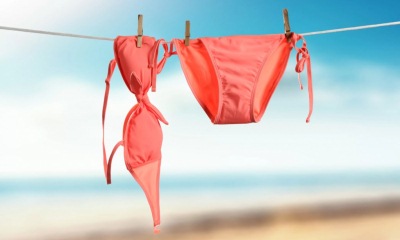 options for possible washing are indicated on the label;
options for possible washing are indicated on the label;- hand wash is preferable;
- machine operation is possible only in the "delicate" mode;
- automatic spinning and drying are unacceptable;
- it is not recommended to do any twisting and stretching of matter;
- water does not exceed 30 ° С;
- drying on a radiator or in direct sunlight is prohibited.

